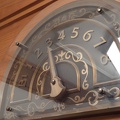Alan Lightman – The Accidental Universe
Recommended by one of my favorite blogs, Brain Pickings, as one of the best books of 2014, and written by physicist and novelist Alan Lightman (Wiki, MIT page), I immediately bought the book (eBook version) and finished it in short time.

A collection of seven assays, titled “The Accidental Universe”, “The Temporary Universe”, “The Spiritual Universe”, “The Symmetrical Universe”, “The Gargantuan Universe”, “The Lawful Universe”, and “The Disembodied Universe”.
In all the essays, Lightman tries to walk the line between science, in particular physics, and religion. This is of course a long – a never ending – discourse, and Lightman, well aware that he is a scientist, tries to provide a view onto the universe compatible with science and religion, mainly by stipulating that the sum is more than the parts, that (in particular) the human is more than just the interaction of the chemical/physical pieces.
While I am always sceptical with these kinds of endeavours, one of the quotes in the book created a very strong deja-vu in me:
The extremely personal and immediate nature of the transcendent experience described here is what gives it power and force. The clergyman who underwent the moment on the hilltop has no doubt of what he felt, and that remembered feeling represents a kind of truth, a knowledge of his own being and his felt connection to the cosmos. No other person can negate that personal experience.
It sounded like the absolute opposite of what I heard long time ago in a Buddhist monastery in Nepal, where I stayed for two weeks. There, when an American nurse was speaking about her experiencing perfectness at rare times with patients, in their final moments, in a complete state of peace, a (western) monk replied: There is no perfection in this world!
I remember how I was really upset about this monk, denying, and above all, invalidating, this person her own experience, out of dogmatic reasons and teachings. Maybe it was this monk that turned me away from this particular style of Buddhism? But anyway, let us return to the book.
The essays are spiked with (astro)physical data and information, presented in a very nice way, so that non-physicist readers, too, can enjoy and learn a lot. This is a big plus of this collection of essays.
On the minus side, the tumbling along the borderline of science and religion remains unconvincing. Well, what did I expect? Surely not an answer on the existence of a supreme being!? But then, it also remains rather unclear about how a scientist can be at the same time religious.
Besides the religion-science border line fights, the last essay “The Disembodied Universe”, also dives into sociology and (the usage of) new media. Here Lightman looses his trail completely. Complaining about (ab)use of modern media, stipulating that they are only used to the good when used for science, is too cheap. Thus the book closes with a rather gloomy essay, full of criticism and fatalism of modern times. And although the author sees this inconsistency when mentioning that the same complaints have been made a century ago, he does not realize, or he does not admit, that it might just be his own mind that cannot cope with it, and not the (mis)development of the society.
Despite the last, for me boring and uninteresting, essay, the book collects a few well written and interesting treatments on current physics and the relation to religion. Concise, not over-boarding, and entertainingly written, the book is a good past-time enjoyment, but lacks deeper insights and suggestions.

